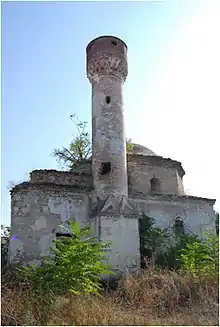| Ahmed Bey Mosque | |
|---|---|
 The mosque today | |
| Religion | |
| Affiliation | Islam |
| District | Pella |
| Region | Central Macedonia |
| Ecclesiastical or organizational status | closed |
| Location | |
| Location | Giannitsa, Greece |
| State | Greece |
 Shown within Greece | |
| Geographic coordinates | 40°47′40″N 22°24′32″E / 40.79444°N 22.40889°E |
| Architecture | |
| Founder | Ahmed Bey |
| Specifications | |
| Height (max) | 15.87 m. |
| Dome(s) | 1 (half-collapsed) |
| Minaret(s) | 1 |
| Materials | Brick, stone |
The Ahmed Bey Mosque (Greek: Τζαμί Αχμέτ Μπέη, from Turkish: Ahmet Bey Camii), also known as the Sheikh Ilahi Mosque (Greek: Τζαμί του Σεΐχη Ιλαχή), is a historical mosque of the Ottoman period in the town of Giannitsa, in northern Greece. It was built in the fifteen century by Ahmed Bey, the grandson of Gazi Evrenos, the conqueror of Thrace and Macedonia and founder of the town. Today it stands in very poor condition, and entrance to it is difficult due to all the plant life that covers it. It is one of the three surviving mosques in Giannitsa today, out of the twenty that existed once.
History
The Ahmed Bey Mosque is one of the oldest mosques in Giannitsa and in Greece overall, built shortly before 1450[1] or during the second half of the fifteen century.[2] The mosque took its name from one Ahmed Bey, the grandson of Gazi Evrenos who founded the town of Giannitsa.[3] In its early years, it was a great place for pilgrimage as the grave of Sheikh Ilahi, a 15th-century scholar, was located there, along with the tomb of Gazi Evrenos himself.[3] Following his death, Gazi Evrenos received honours similar to those of a saint, and the Muslim inhabitants of Giannitsa adorned his town with several monuments and institutions, such as tekkes, madrasas, and mosques.[4]
In the twentieth century, the mosque was given to the Greek Army to use, which in turn gave it up to the local municipality along with the military camp that rose around it.[2] Access to the mosque is not easy due to the abundant vegetation around and on the building, and perhaps due to this it was only registered as a monument in 1990.[2]
Architecture

The mosque has a simply design, and consists of a square hall prayer, a portico and a minaret.[3] The mosque sports stony zones of three or four rows of bricks that form a building system of incomplete surrounding brick.[5] In its interior the mihrab is preserved, and some places its decoration is also visible.[2]
The minaret, which now stands at 15.87 metres in height, is preserved up to the balcony with the tip missing, but around half of the seven-metre tall dome collapsed after an explosion in the 1970s;[6] traces of painted decoration are still visible nonetheless.[7]
Half-destroyed and struggling to stand, the mosque is in urgent need of restoration work, which have never been implemented, nor is there any plans for such works in the near future.[2]
See also
References
- ↑ Ameen 2017, p. 22.
- 1 2 3 4 5 Stavridopoulos 2015, p. 196.
- 1 2 3 Skiadaresis 2012, pp. 1–2.
- ↑ Stavridopoulos 2015, p. 191.
- ↑ Loukma & Stefanidou 2016, p. 4.
- ↑ Loukma & Stefanidou 2018, p. 177.
- ↑ Loukma 2019, pp. 150–151.
Bibliography
- Ameen, Ahmed (2017). Islamic architecture in Greece: Mosques. Alexandria: Center for Islamic Civilization studies, Bibliotheca Alexandrina.
- Loukma, Maria; Stefanidou, Maria (2018). "Causes of deterioration of ottoman mosques". Islamic Heritage Architecture and Art II. Vol. 177. Southampton: WIT Press. ISBN 978-1-78466-251-6.
- Loukma, Maria (2019). Τεχνολογία, υλικά δόμησης και παθολογία σε θρησκευτικά κτήρια της οθωμανικής περιόδου [Technology, construction materials and pathology in religious buildings of the Ottoman period] (PDF) (Thesis) (in Greek). Thessaloniki: Aristotle University of Thessaloniki.
- Loukma, Maria; Stefanidou, Maria (2016). The Morphology and Typology of the Ottoman Mosques of Northern Greece (PDF) (Thesis). Greece: Laboratory of Building Materials, Aristotle University of Thessaloniki.
- Skiadaresis, Georgios (2012). The Ottoman monuments of Giannitsa. Ephorate of Antiquities of Pella.
- Stavridopoulos, Ioannis (2015). Μνημεία του άλλου: η διαχείριση της οθωμανικής πολιτιστική κληρονομιάς της Μακεδονίας από το 1912 έως σήμερα [Other People's Monuments: the Management of the Ottoman Cultural Heritage of Macedonia from 1912 to the present] (Thesis) (in Greek). Ioannina: University of Ioannina.

